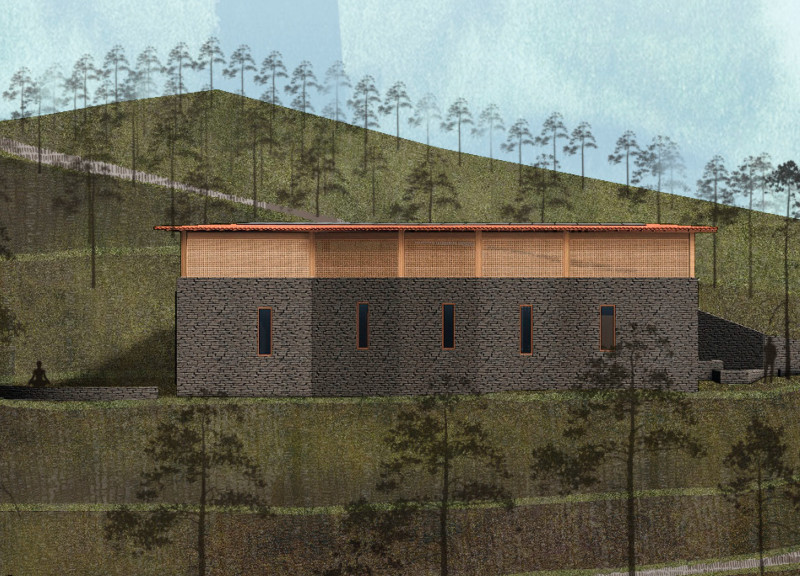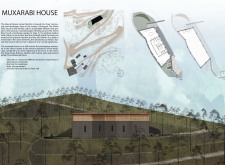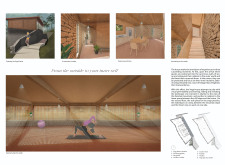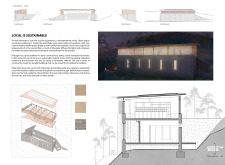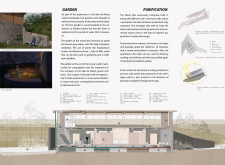5 key facts about this project
At its core, the design represents a journey from the external environment into a space dedicated to self-discovery and community bonding. The architectural approach prioritizes the user experience, creating distinct zones that facilitate various activities, including communal gatherings and personal contemplation. One of the key aspects of Muxarabi House is its entry pathway, which meanders gently through lush vegetation, guiding visitors into a calming world that fosters a sense of arrival and peace. This approach establishes a connection between the house and the natural world, inviting occupants to reflect and engage with their surroundings from the moment they arrive.
Upon entering the Muxarabi House, guests are greeted by cavernous spaces characterized by robust stone walls that not only provide a sense of shelter but also create an atmosphere of warmth and welcome. The integration of communal areas, such as the kitchen and dining space, is essential for fostering social connections among residents and visitors alike. Large windows and openings allow natural light to flow freely into these spaces, seamlessly connecting indoor and outdoor environments and further enhancing the feeling of spaciousness.
The yoga studio, strategically positioned on the second floor, exemplifies the project’s commitment to wellness and mindfulness. Designed to accommodate various practices, this adaptable space features expansive views that visually connect practitioners to the rolling landscape of the Zêzere River, enriching their meditative experience. Furthermore, the inclusion of dedicated garden spaces enhances the design’s engagement with nature. The purifying garden, for instance, employs native plants that assist in filtering gray water, merging ecological functionality with aesthetic appeal.
Materiality is a significant consideration in the Muxarabi House, as the architecture utilizes locally sourced resources to minimize environmental impact while reinforcing regional characteristics. The use of local stone pays homage to the traditional building practices of the Aleiro region, offering both durability and a visual connection to the landscape. Complementing this, cork is employed for flooring and partition walls, providing an effective and sustainable insulation method. Local timber features prominently in the structure, creating a warm ambiance that reflects the house’s natural surroundings. The intelligent use of glass further enhances the architectural balance, as it allows light to permeate the interior and fosters a sense of unity between indoor spaces and the external environment.
Sustainability is at the heart of the Muxarabi House’s design. The integration of eco-conscious strategies, such as a rainwater collection and purification system, demonstrates a commitment to harnessing natural resources responsibly. Additionally, the incorporation of photovoltaic panels on the roof aligns with the project’s overarching goal of self-sufficiency, reducing reliance on external energy sources. The choice of materials and thoughtful architectural orientation further contribute to effective thermal regulation, ensuring comfort throughout the year without excessive dependence on artificial heating or cooling.
One of the defining features of the Muxarabi House is how it revitalizes traditional Portuguese architectural elements while embracing contemporary needs and ideas. This project creates an environment that promotes individual reflection while encouraging communal interaction, effectively enhancing the social fabric of the retreat. The innovative design approaches taken in Muxarabi House exemplify a deeper understanding of user experience and environmental context, positioning it as a model for future architectural endeavors within similar settings.
For those interested in delving deeper into the architectural aspects of the Muxarabi House, exploring the architectural plans, sections, and various design elements can provide invaluable insights into the thoughtful details that define this project. The careful consideration given to every aspect of its design serves to inspire and inform those looking to understand how architecture can harmonize with nature and foster wellness.


